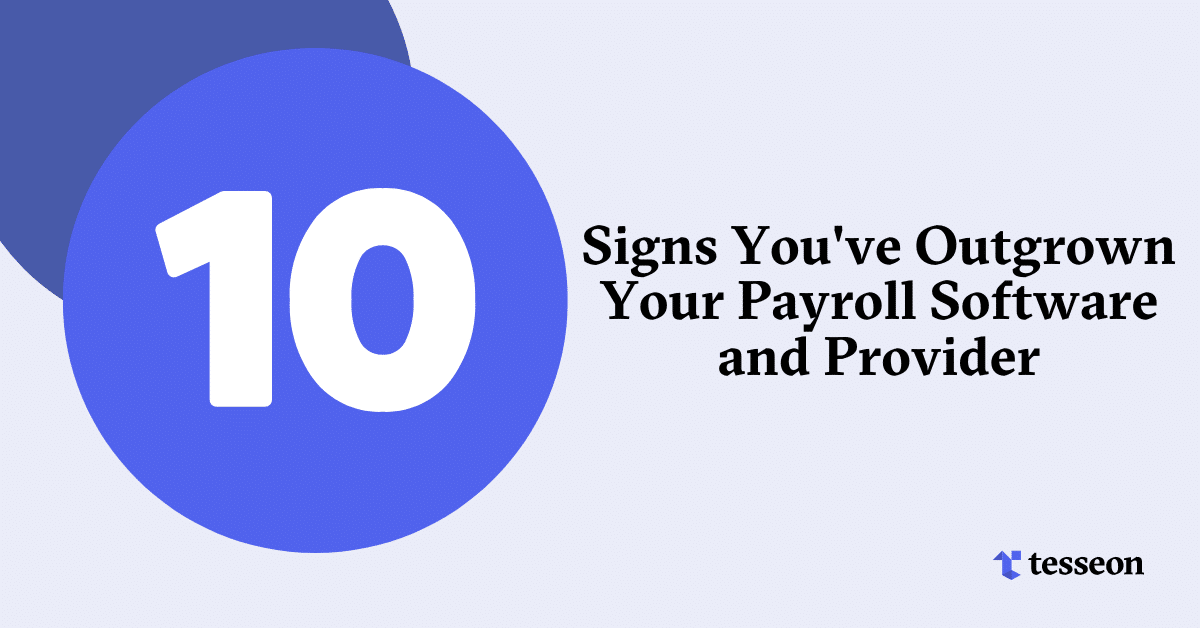10 Signs You’ve Outgrown Your Payroll Software and Provider
April 3, 2024
As your business grows and evolves, your payroll needs change. What once worked for your small startup may no longer suffice as you expand your team and face new challenges. It’s crucial to recognize when it’s time to upgrade your payroll software and provider to ensure smooth operations and compliance. Here are ten signs that indicate you’ve outgrown your current payroll setup:
- Time-consuming manual processes: If you find yourself manually entering employee hours, pay rates, and deductions, or calculating taxes, overtime, and other complex payroll scenarios by hand, it’s a clear sign that your current payroll software isn’t meeting your needs. These manual processes are not only time-consuming but also prone to errors and discrepancies.
- Disconnected systems and data silos: When you’re juggling multiple systems for HR, time tracking, benefits, and payroll, it leads to data silos and manual data transfer between systems. This can result in errors, inconsistencies, and a lack of real-time data synchronization. If you don’t have a single source of truth for your payroll data, it’s time to consider an upgrade.
- Limited reporting and analytics: As your business grows, you need access to comprehensive payroll reports for audits, compliance, and decision-making. If you’re struggling to generate customized reports, drill down into specific data points, or lack visual dashboards and analytics to spot trends and anomalies, your current payroll software may be falling short.
- Unresponsive or inadequate customer support: When you encounter payroll issues or have questions, you need reliable and knowledgeable customer support. If you experience long hold times, slow response rates, or support representatives who lack payroll expertise or industry-specific knowledge, it’s a red flag. Having no dedicated account manager or point of contact for ongoing support can also be a drawback.
- Inflexible pay schedules and employee classifications: If your current payroll software has difficulty accommodating multiple pay frequencies (weekly, bi-weekly, semi-monthly) or diverse employee types (full-time, part-time, contractors, interns), it may not be suitable for your growing business. Limitations in managing multiple pay rates, shift differentials, and bonus structures can also be problematic.
- Challenges with multi-state and international payroll: As your company expands geographically, you may struggle to keep up with varying state and local tax regulations or manage payroll for employees working across different states or countries. Ensuring compliance with international payroll requirements and local labor laws can also be a challenge if your current provider isn’t equipped to handle it.
- Poor employee self-service and mobile access: In today’s digital age, employees expect easy access to their payroll information. If your current software lacks an employee portal for viewing pay stubs, updating information, and requesting time off, or doesn’t offer a mobile app for on-the-go access, it may be time for an upgrade. Manual distribution of physical pay stubs and W-2 forms can also be a hassle.
- Outdated technology and security concerns: If your payroll software runs on legacy systems or outdated technology, it may be more vulnerable to security threats. Lack of regular software updates, security patches, and concerns about data privacy, encryption, and protection against payroll fraud are all signs that it’s time to switch to a more modern and secure solution.
- Inability to scale and adapt to business growth: As your company grows, your payroll software should be able to handle an increasing employee count and complexity. If you find that your current system lacks customization options to fit your unique business needs and processes or has difficulty integrating with other tools and platforms, it may not be scalable enough for your expanding organization.
- Hidden costs and lack of transparency: If you’re faced with unexpected fees for setup, training, support, or additional features, or struggle to understand complex invoices and billing statements, it can be frustrating. A lack of clarity on pricing structure and long-term costs can also make budgeting and forecasting difficult.
If you’ve recognized any of these pain points in your current payroll setup, it’s time to consider upgrading to a more comprehensive, user-friendly, and scalable payroll software and provider. By addressing these issues and investing in a modern payroll solution, you can streamline your processes, ensure compliance, and focus on growing your business.
share this blog
STAY CONNECTED
Sign up for our newsletter for the latest Tesseon information.
Related Blogs
What our clients are saying about us
Disclaimer: The information provided on this blog page is for general informational purposes only and should not be considered as legal advice. It is advisable to seek professional legal counsel before taking any action based on the content of this page. We do not guarantee the accuracy or completeness of the information provided, and we will not be liable for any losses or damages arising from its use. Any reliance on the information provided is solely at your own risk. Consult a qualified attorney for personalized legal advice.

